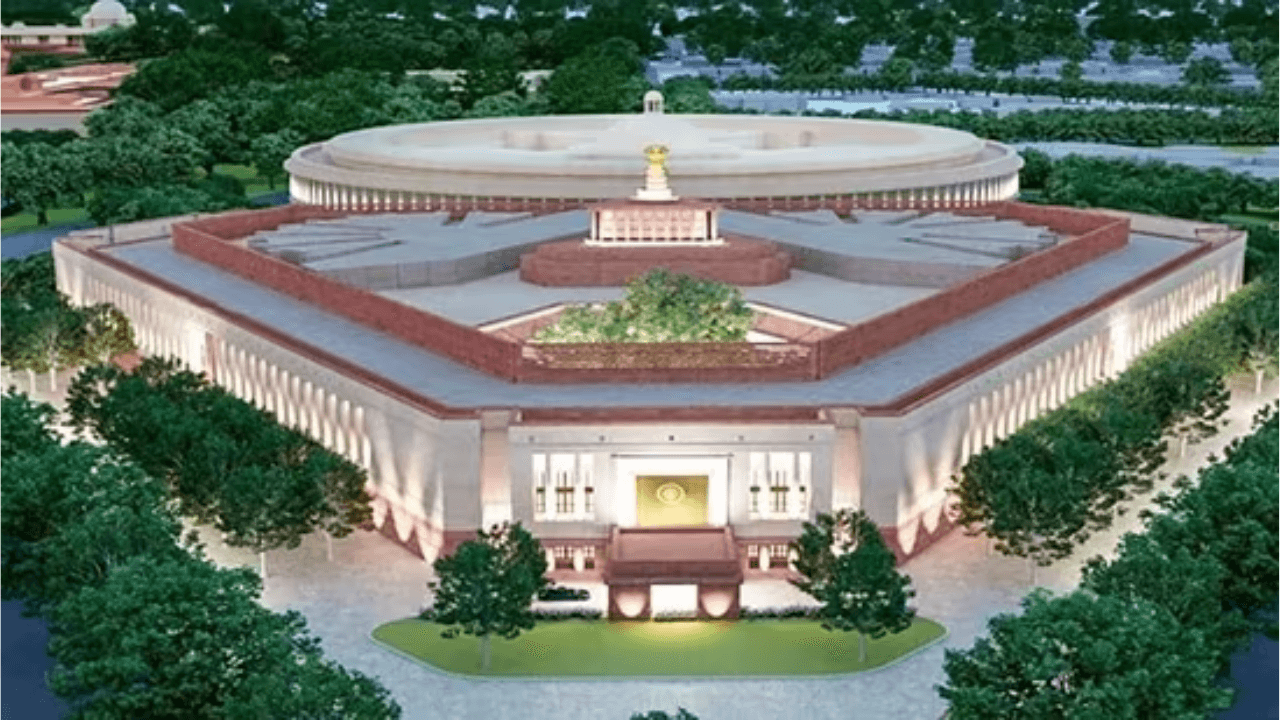Prime Minister Narendra Modi is all set to inaugurate India’s new Parliament building on Sunday, May 28. The grand unveiling will showcase the building’s stunning artwork and feature a ceremonial sceptre known as ‘Sengol’ among its many highlights. The construction of the new Parliament complex, which comes at a cost of ₹971 crore, stands as a symbol of India’s progress and reflects the aspirations of its 1.35 billion citizens. With its innovative triangular design, the building maximizes space utilization, fostering efficient governance.
Key Facts about India’s New Parliament House
Here are the key facts about the new Parliament House:
- Triangular Design for Optimum Space Utilization: The new Parliament House boasts a unique triangular shape, ensuring efficient space utilization within the complex. This design allows for maximum functionality and accommodates larger legislative chambers.
- Lok Sabha: Inspired by the Peacock: The Lok Sabha, inspired by India’s national bird, the peacock, will have an expanded seating capacity. With 888 seats, it will accommodate nearly three times the current capacity. The Lok Sabha hall will also be able to accommodate 1,272 seats for joint sessions.
- Rajya Sabha: Inspired by the Lotus: The Rajya Sabha, inspired by the national flower, the lotus, will have 348 seats. The new design accounts for future increases in the number of Rajya Sabha members, ensuring sufficient space in the House.
- Constitutional Hall: A notable addition to the new Parliament House is the Constitutional Hall, located in the center of the complex. This hall will serve as a significant space within the building.
- No Central Hall: Unlike the old Parliament House, the new complex will not feature a Central Hall. The low capacity of the previous Central Hall necessitated additional chairs during joint sessions, creating security challenges. The Lok Sabha Hall in the new Parliament House is designed to easily accommodate joint sessions.
- Earthquake-resistant Construction: The new Parliament building is designed to withstand earthquakes. Considering Delhi’s classification in Zone 4, characterized by a higher earthquake risk, the new structure will be fortified to endure strong shocks in Zone 5.
- Modern Facilities: Each seat in the new Parliament House will be equipped with a multimedia display in front, providing modern amenities to members of Parliament. This enhancement will improve the legislative experience and facilitate communication.
- Eco-friendly Construction: The new Parliament House adopts eco-friendly practices, utilizing green construction materials. The building incorporates energy-saving devices, reducing electricity consumption by 30%. Rainwater harvesting and solar power generation systems are also integrated into the design.
- Enhanced Committee Rooms: The new Parliament House will feature an increased number of committee rooms, equipped with sophisticated audio-visual systems. These upgrades will facilitate the functioning of parliamentary committees.
- Media Facilities: Special facilities will be provided for the media, including 530 seats dedicated to media personnel. Galleries will be available for the general public to witness parliamentary proceedings, ensuring a clear view of the house from every seat.
- Public-friendly Design: Efforts are underway to make the new Parliament House more accessible to the public. Two special entrance points will be designated for children, the elderly, and disabled individuals to access the Public Gallery and Central Constitutional Gallery. Additionally, the new building will incorporate improved fire safety measures.
Inauguration to be Marked by New ₹75 Coin
To mark the inauguration of the new Parliament building, the Union Finance Ministry will launch a special ₹75 coin. The circular coin will have a diameter of 44 millimeters and will be composed of a quaternary alloy—50% silver, 40% copper, 5% nickel, and 5% zinc. The face of the coin will bear the Lion Capitol of Ashoka Pillar in the center, with the legend “सत्यमेव जयते” (Satyameva Jayate) inscribed below. It will also feature the words “भारत” (Bharat) in Devanagari script and “INDIA” in English on the periphery. The reverse side of the coin will display an image of the parliament complex, with the inscription “Sansad Sankul” in Devanagari script on the upper periphery and the words “Parliament Complex” in English on the lower periphery.
- 3 August Current Affairs 2023 in English
- MoU Between Subroto Mukerjee Sports and Education Society and All India Football Federation (AIFF) to Promote Football at Grassroot Level
- Dr. Mansukh Mandaviya Delivers Keynote Address at the 13th Indian Organ Donation Day ceremony
- Education Ministry Forms Expert Panel on Anti-Discrimination in Higher Education
- Concerns Arise Over Cheetah Deaths at Kuno National Park
